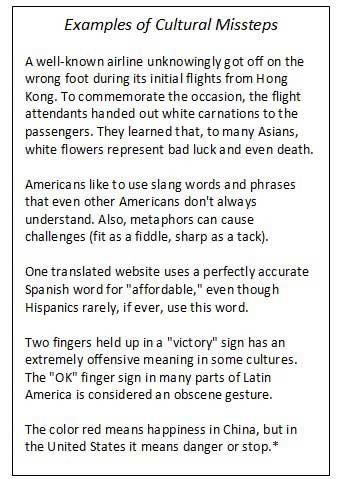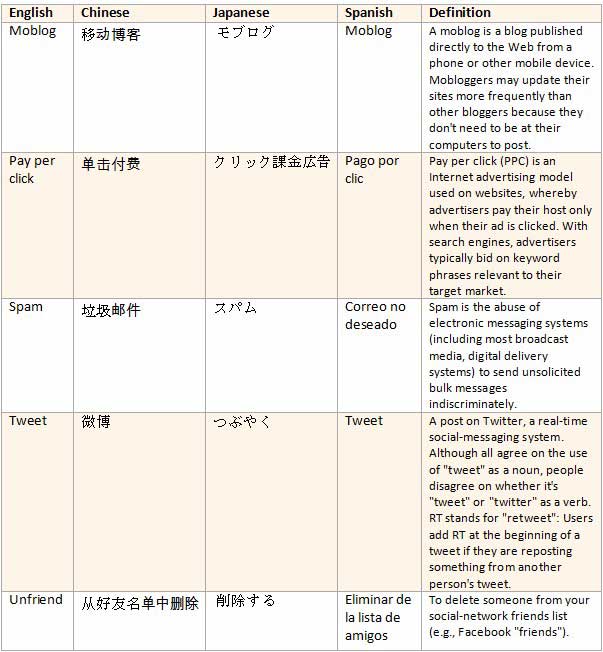Language continues to evolve and cross national and cultural borders, and its users have always helped shape its evolution. Take, for example, the New Oxford American Dictionary's 2009 Word of the Year, "unfriend."
It was said to be an official term that Facebook used. But according to other reports, "unfriend" is what community users came up with, whereas the official Facebook term is "remove connection."
Either way, each culture, including regional cultures within larger cultures, develops unique sets of jargon and slang.
In an age of digital media, how are such new terms being translated? But first, what is digital media? This definition sums it up nicely: "Digital media consists of the various platforms on which people communicate electronically."
We know that interactive media platforms are a global phenomenon, occurring in all markets regardless of the level of economic, social, and cultural development in those markets. People are using those platforms to communicate and interact. Therefore, when translating content into other languages, it's critical to define clearly. But what is the best approach? How does search-engine optimization (SEO) factor into the equation? What do properly translated digital-media terms in Spanish, Japanese, and Chinese look like?
 Building Your Brand Globally—Tips for Localizing Your Digital-Media Campaigns
Building Your Brand Globally—Tips for Localizing Your Digital-Media Campaigns
In the United States, it is important to build your personal brand. However, in Germany or the United Kingdom, pointing out your successes is, except when done very tactfully, considered boasting rather than legitimate communication. It'll put people off.
Latinos, generally speaking, are a very experiential culture, driven more by emotion and experience than by data.
Asian Americans, as a broad generalization, focus on the good of the group, which takes precedence over the individual.
The biggest mistake most marketers make when marketing to ethnic communities is applying a general strategy. A one-size-fits-all approach when developing marketing strategies intended to motivate a "specialized group" will produce less-desirable results, because "brand building" will have been lost.
Understanding cultural differences is important for effective global-branding strategies. As brands enter different cultures, it becomes imperative for them to carefully adopt the brand elements (images, advertising, channels, and others) to appeal to the targeted culture's tastes and preferences.
Cultural differences can be morphed from a challenge to an opportunity when brands learn from industry best-practices and adopt their branding strategies to adequately reflect consumers' preferences.
The increasing popularity of digital media offers brands very powerful tools to involve customers and bring brands closer to the local culture by providing customers a platform in which to interact with the brand on their own terms.
Remember, the cultures and languages of ethnic communities differ; therefore, marketing strategies must be specific to each ethnic group.
Through various research methods—including social-network monitoring and competitive keyword search—marketers can track relevant trends, adjusting tactics to pursue a selective social-networking approach based on what the target audience is saying and doing.
Several great tools can help you learn what is important to your community and how those in that community are searching for product or services information. Many of those tools allow you to listen down to the ZIP code level.
These three great tools help determine how people are searching nationally and in your area:
- Google Insights for Search
- Twitter Advanced Search
- RSS feeds based on keywords
Tips for multilingual SEO
Localize for your target audience. But remember that localization goes beyond translation. For either to really work in the target culture, it must to take into account those nuances of culture and language that are at the heart of true communication. So although a translation may be accurate linguistically, you must also pay extra attention to the broader context in which it will be used.
Host natively. If reaching out to another country, host your website on a server in your targeted country. Doing so helps with credibility and increases organic search-engine benefits.
Register for regional domains. If you are focusing primarily on UK search engines, for example, register a .co.uk domain.
Include regional links. Include links from websites in the same region or cultureto help increase search results.
Collect specific terms and keywords. Collect search terms and keywords that are popular with your potential audience and relevant for searches conducted in the target language.
Why Use a Terminology Guide?
A terminology guide can be one of the most valuable language assets when translating into a language as widely spoken and greatly varied as Spanish, Japanese, or Chinese, for example.
The goal of a terminology guide is to determine the appropriate expression of words and ideas for your specific audience and ensure that they are employed consistently.
Terminology guides can resolve and prevent many issues related to vocabulary, and they can be particularly useful when dealing with specialized terms.
Travel writer Doug Lansky says in his blog: "With nearly a billion people speaking English as a first, second, or third language and 800 million international trips taken in the last year, companies are international whether they plan to be or not."
"The lingual landscape is changing before our eyes," he adds, saying linguistic gaffes are one of the results. He says being familiar "with the most common gaffes" can help avoid them. Using proper terminology is another. (Check out his post, "The Funniest Marketing Fails of All Time.")
Here's a sampling of properly translated digital-media terms:

(Download the digital-media-terminology guides in their entirety: Spanish, Chinese, and Japanese. Registration required.)
Providing virtual access to your organization in a way that facilitates social exchange and interaction will help foster trust and credibility.
Language is used to describe how we feel and how we see the world. But in an online environment it's about how we interpret what's being said or read.
Give careful thought to your key messages and how virtual communities interpret your words, meanings, and actions. When done well, that goes a long way toward building an authentic online environment.
Tips and resources
Translation companies can help you do a cultural assessment if you aren't sure where to start or help guide you pre-translation. See these tips on how to choose a translation agency.
For some solid digital-media basics, take a look at this July 2009 study that focuses on social-networking engagement strategies of top brands such as Starbucks, SAP, and Dell: "The world’s most valuable brands. Who's most engaged?" (pdf).
*For more information on colors, check out this "color meanings" chart (pdf).




